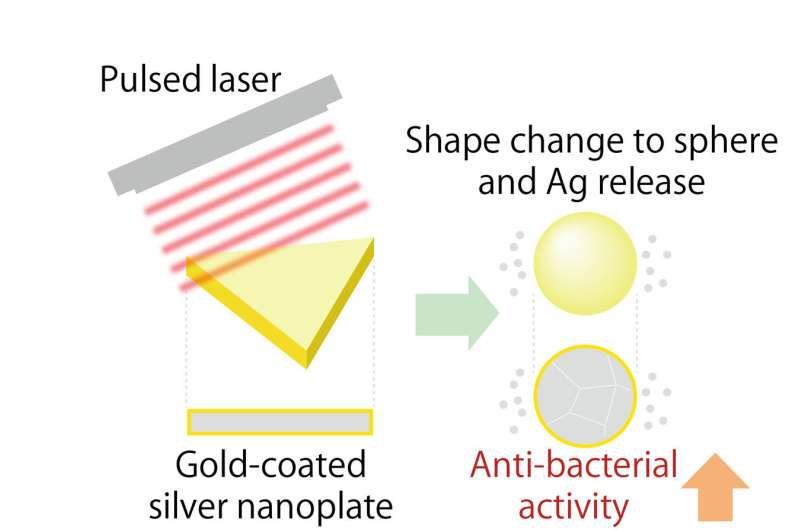Nanoparticles with pulse laser controlled antibacterial properties

Silver nanoparticles (AgNPs) are known to have excellent antibacterial properties and are considered by many to be a strong contender in the critical search for an answer to antibiotic-resistant bacteria. They block enzymes and can cause bacteria to have irregularly shaped membranes, producing results ranging from inhibited growth to cell death. However, a collaboration of researchers from Kumamoto University, Keio University, and Dai Nippon Toryo Co., Ltd. in Japan found that AgNPs have a propensity to conglomerate, which results in a reduction of antibacterial attributes. They solved the conglomeration problem by coating the nanoparticles with gold. Unfortunately, this also caused a reduction of the antibacterial effects since the silver was no longer exposed. This prompted the researchers to search for a method to keep the shape of the nanoparticles as well as the antibacterial properties.
Pulsed laser irradiation on the gold-coated silver nanoparticles (Ag@Au NPs) provided a solution to the problem. When Ag@Au NPs are irradiated with a pulse laser, the morphology of the NPs changes from a triangular plate to a spherical shape. This is due to the metals melting from the heat of the laser pulse. The researchers showed that Ag@Au NPs were about half triangular and half spherical before irradiation but jumped to 94% spherical after irradiation. Furthermore, the silver-to-gold ratio of the pre-irradiation Ag@Au NPs was around 22:1, but the post-irradiation ratio was near 4.5:1. This was interpreted by the researchers as the generation of defects in the gold-coating which allowed for some of the silver to escape as ions. This is an important aspect of the pulsed laser irradiation process since the release of silver produces the bactericidal effect.
"We have developed a method to activate the antibacterial properties of silver nanoparticles at will," said Professor Takuro Niidome, leader of the research group. "Our experiments have shown that, while non-irradiated gold-coated silver nanoparticles have only minor antibacterial properties, the effects are significantly increased after pulsed laser irradiation. We hope to develop this technology further as a method of managing bacteria that have developed antibacterial resistance."
The irradiated Ag@Au NPs were highly effective against Escherichia coli, resulting in a 0% colony survival rate. Silver NPs alone were similarly effective, but the Ag@Au NPs had the advantages of being activated as needed and did not tend to clump together like the silver NPs.
This research was posted online in the Royal Society of Chemistry journal Nanoscale on 11 October 2017.
More information: Kaung Kyaw et al, Effects of pulsed laser irradiation on gold-coated silver nanoplates and their antibacterial activity, Nanoscale (2017). DOI: 10.1039/c7nr06513b
Journal information: Nanoscale
Provided by Kumamoto University




















